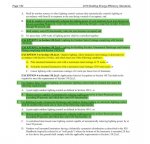Lighting controls have obviously become much more complicated than they used to be.
Has anyone found a good way to show exactly what you want on a bid set of drawings?
I know manufacturers usually provide detailed shop drawings that show wiring and all the devices and connections. But they can't do that until they understand what I'm expecting.
Its easy to show all the power wiring, and device locations. But that doesn't convey which lights make up a zone, or which switches and sensors control which zone.
And then there are also many different options for each zone: manual on, auto on, time control, daylight control, dimming, and on and on.
So what is the easiest and best way to show this?
Has anyone found a good way to show exactly what you want on a bid set of drawings?
I know manufacturers usually provide detailed shop drawings that show wiring and all the devices and connections. But they can't do that until they understand what I'm expecting.
Its easy to show all the power wiring, and device locations. But that doesn't convey which lights make up a zone, or which switches and sensors control which zone.
And then there are also many different options for each zone: manual on, auto on, time control, daylight control, dimming, and on and on.
So what is the easiest and best way to show this?







